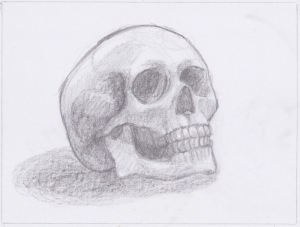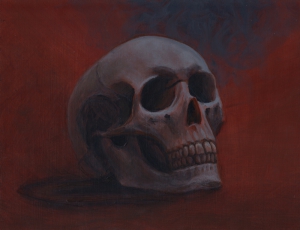
Skull Finished Painting
Skull Painting Narrated Timelapse (Acrylics on Plastic)

Initial Sketch

Underpainting

Skull Finished Painting
I did a lot of research several tests before trying the techniques I tried here. And the painting seems to be stable for now, but I can’t guarantee anything, please do your own tests with your own materials and draw your own conclusions. Usually if there are problems it tends to happen within the first few days. As of now (two weeks), the painting is stable enough. The paint has not cracked or peeled (not even from purposely trying to peel it with tape), and the plastic (it’s HIPS plastic) is in great condition (the medium heat from the blow dryer did not bend it out of shape). Update: I did do a swab test (softly rubbing a wet cotton swab on the surface) at two weeks and I did get some very minor lifting in the background, but still nothing with the tape and nothing where I then painted the light in with gray over that red background. So I don’t think it’s something to worry about as long as I add an isolation layer of pure medium over everything. Whatever lose pigments remain from the under-bound paint look like they’re easily contained by another proper layer of paint. Overall it satisfies me. I’ll report back further once I add this layer.The only thing is I painted all the way to the edge and the paint is kind of ragged there, liable to being accidentally peeled from handling roughly. Before I didn’t paint to the edges because I used the edges to handle the canvas paper. I kept doing that for a while even though I started to secure my pages because they were already marked for it. But for this I thought there was no point, well now I realize it’s probably better to continue that habit.
Also all the water made the plastic stick to the paper I was using to hang it from. I managed to unstick it and rub it off with just some water, but some of the gesso came off. I repainted it, and it’s all fine. Not really the fault of the plastic (just the sheer amount of water would have ruined a painting in canvas paper), but more bad planning on my part.
Tests
Propylene Glycol (Retarder)
The complete chart will be available in the next post when I post the tutorial on the stay wet palette and I’m planning on redoing it, along with more detailed strength tests, in the summer. But basically, I set out propylene glycol in different proportions to very cheap crafts acrylic (from 3:1 to 1:3) and they have all dried within a week and have not left the paint sticky in any way. And it’s winter here where I live so it’s not that it was hot and that helped it.
The paint films also seem remarkably strong (only tested through touch). I expected more problems at the higher ratios but there weren’t any. A thin brushed on layer of pure PG also evaporates within a couple days and can be made to evaporate within the day by blow-drying the painting on medium heat for a few minutes. It’ll still remain sticky for a few hours, but you’ll have helped the initial moisture evaporate and after that it should be completely dry by the next day and not sticky at all. The paint didn’t reactivate or anything at that point.
Water
I also tried some similar quick tests with water. There was no noticeable problems when diluting excessively as long as the paint already had some base to adhere to (the recommended is usually 50% for mediums, less for tube paints). Canvas paper works out of the box and so would anything pre-primed. Plastic needs some gesso (I used 2 coats) or a relatively thick underpainting (if you did the entire underpainting diluting only with medium, that would probably work as well) and should also be sanded beforehand to provide a better physical bond for the paint. But once you’ve got that thick base of paint with a good mechanical bond, you’re good to go.
Additionally I found this reply by Golden (scroll down past the video) regarding water saying that at least with their paints this isn’t true and you can get away with going much more than 50% with tube acrylics and they’ll still have decent adhesion. They also described some methods for testing this similar to what I’d used. Also they confirmed as I suspected (because when you do hear about acrylics peeling it’s always on a recent painting), any problems with adhesion should be apparent fairly quickly, within days. That’s why I’m confident the skull painting is fine at this point. Update: I found a better instructions for their test, that’s a bit different from what was suggested in that link.
HIPS (High Impact Polystyrene) Plastic as a Painting Substrate
I used 0.5mm plastic for this painting. More than half a year ago I put two pieces of plastic on my window, 0.3mm and 1mm taped with masking tape, with one part covered in a thin layer of gesso.
There has only been noticeable yellowing (it’s too little to properly photograph) on the exposed plastic. 0.3mm did worse than 1mm. When I took off the masking tape (which by that point had turned a disgusting yellow) and took off the gesso with some alcohol, the plastic looked brand new, and unlike paper would be, was not contaminated by the yellowing masking tape.
Based on this I would keep 0.5mm plastic to do studies. It’s about the same price, if not cheaper than canvas paper per cm, at least where I live. Leave 1mm plastic for a good painting. And 2mm for something rigid that can replace canvas (1mm is still very flexible).
I wouldn’t use this for a commission or sell a painting on plastic without warning the person, at least not at this point in my tests, but I am looking into the more expensive UV resistant plastics for those situations. I’m also going to test whether it’s possible to wrap the plastic in canvas, much like MDF panels are, but without the downsides of MDF (it’s always humid where I live and I have an ever growing hatred of anything made from MDF), at which point there should be no UV related problems with such thick protection from the canvas.
These I feel are just a better replacement for papers / canvas papers (which warp, crease, and yellow if in contact with non-archival stuff), cheap bad quality canvases, expensive woods, and unavailable woods (they don’t sell birch where I live, the blasphemy) or unavailable alternatives (I can’t find the name, but there was this brand that made some sort of archival plastic board, or at least they claimed it was archival, never tried it, but it was interesting. Edit: Found it.. Edit2: Found a similar board.).
The bigger issue than yellowing I think before these tests satisfy me is how strong the plastic remains. I know from experience trying to make PVC bows that if the PVC is old the tube will shatter with relatively minimal pressure, but this is kind of hard to test with small pieces of HIPS, and even if I were to put out bigger pieces to test, a sheet is not a tube, and HIPS plastic is either flexible under 1mm or super rigid at 2mm. So I haven’t thought of a good way to do it yet. It would need to involve various samples and some level of precision when applying pressure. And if I had the stuff to test that, I probably wouldn’t be trying to find cheap alternative substrates…
Adherance Tests
Additionally I tried painting straight on the plastic on the glossy side, the matte side, and the matte side sanded. I would avoid the glossy side unless you thoroughly sand the gloss away. The acrylic seems to stick okay to the matte side, but it’s easily peeled. If you sand it though it offers incredible resistance. Just remember how badly acrylic like to stick to plastic palettes, that’s how it sticks, now imagine it’s sanded. The bond is pretty strong. Just be careful when sanding, especially machine sanding, to wear a suitable mask to protect against the dust.
If you like to read very technical stuff, Golden wrote an article once on plastics as a substrate which you might find useful. Unfortunately they don’t note whether the plastics tested had any built in UV protection.
PS: Not sponsored by Golden or anything. I just genuinely liked their products when I lived in the US and they also have an incredible amount of research and information on acrylics. I haven’t seen any other companies do anything like it and it was a big part of what attracted me to the brand in the first place.